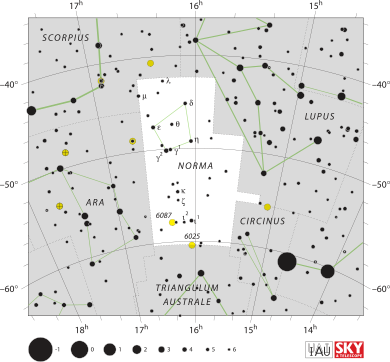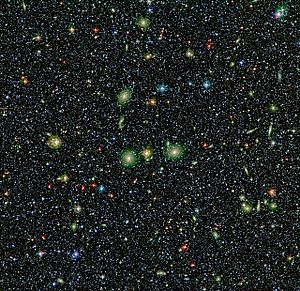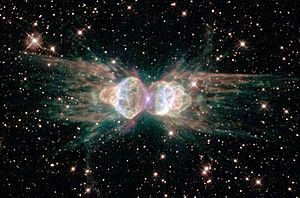Norma (constellation) facts for kids
| Constellation | |

List of stars in Norma
|
|
| Abbreviation | Nor |
|---|---|
| Genitive | Normae |
| Pronunciation | genitive |
| Symbolism | the Normal |
| Right ascension | 16.05 |
| Declination | −52.01 |
| Quadrant | SQ3 |
| Area | 165 sq. deg. (74th) |
| Main stars | 2 |
| Bayer/Flamsteed stars |
13 |
| Stars with planets | 4 |
| Stars brighter than 3.00m | 0 |
| Stars within 10.00 pc (32.62 ly) | 0 |
| Brightest star | γ2 Nor (4.01m) |
| Messier objects | 0 |
| Meteor showers | Gamma Normids |
| Bordering constellations |
Scorpius Lupus Circinus Triangulum Australe Ara |
| Visible at latitudes between +30° and −90°. Best visible at 21:00 (9 p.m.) during the month of July. |
|

The constellation Norma is a small group of stars you can find in the southern part of the sky. It is located between the constellations Scorpius (the Scorpion) and Lupus (the Wolf). Its name comes from a Latin word meaning "normal." This can refer to a right angle or a tool used to draw one.
Norma is often pictured as a ruler, a carpenter's square, or a level. These are all tools used to make things straight and even.
Contents
Exploring the Norma Constellation
Norma is a special constellation because the Milky Way, our home galaxy, passes right through it. This means Norma is full of amazing things to see in space.
Stars of Norma
Even though Norma is a small constellation, it has many stars. The brightest star in Norma is called Gamma2 Normae. It shines with a magnitude of about 4.01, which means it's fairly easy to spot in a dark sky.
Deep-Sky Wonders in Norma
Because the Milky Way runs through Norma, this constellation is packed with interesting "deep-sky objects." These are things like star clusters, nebulae, and galaxies that are far away from Earth.
Star Clusters
Norma contains several open star clusters. These are groups of stars that formed together from the same giant cloud of gas and dust. They are loosely bound by gravity.
Nebulae in Norma
One famous deep-sky object in Norma is Shapley 1. This is a type of planetary nebula. It looks like a glowing ring of gas. Shapley 1 is about 1,000 light-years away from Earth. It formed when a star like our Sun reached the end of its life. The star shed its outer layers of gas into space.
Another fascinating nebula found in Norma is the Ant Nebula, also known as Mz 3. It gets its name because it looks a bit like the head and thorax of an ant. This nebula is also formed from a dying star. It shows us what might happen to our Sun in billions of years.
The Norma Cluster and the Great Attractor
Norma is also home to something truly massive called the Norma Cluster. This is a huge group of thousands of galaxies, all held together by gravity. It's one of the most massive galaxy clusters known.
The Norma Cluster is part of an even bigger mystery in space. Scientists believe it is close to a super-massive region called the Great Attractor. The Great Attractor is a huge, unseen concentration of mass. It pulls our Milky Way galaxy and many other galaxies towards it. Scientists are still studying exactly what the Great Attractor is made of. They think it might be a very large supercluster of galaxies and dark matter.
See also
 In Spanish: Norma (constelación) para niños
In Spanish: Norma (constelación) para niños


